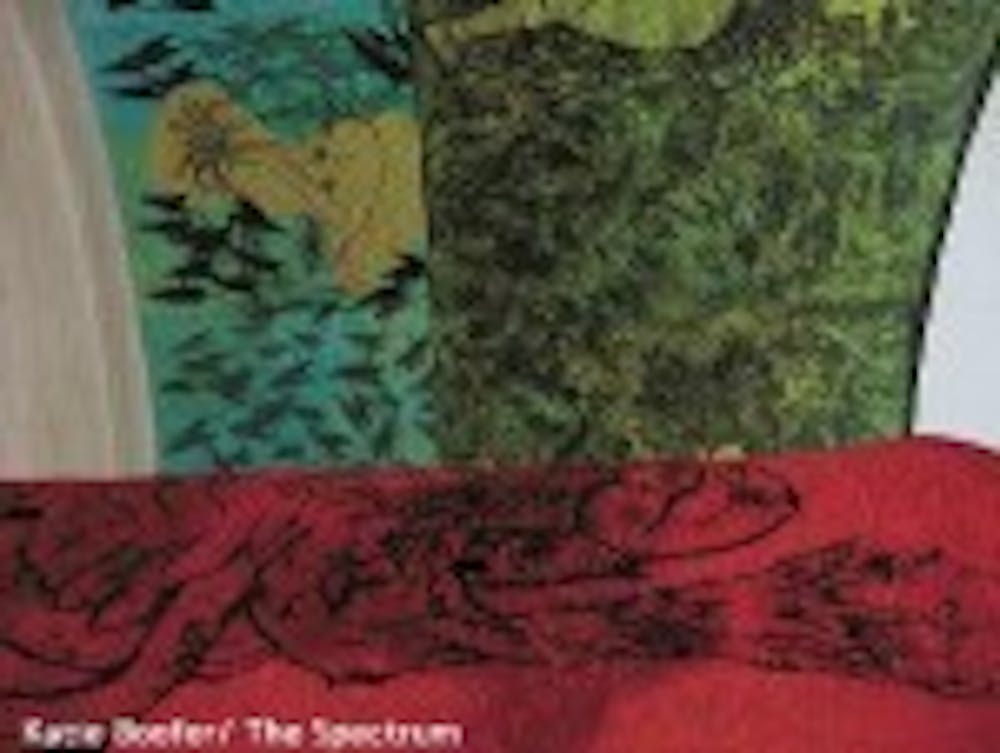Copulating rats, larger-than-life Spyrographs and a Kama Sutra pool cover have taken over the Center for the Arts.
"Haunted Screens," a new showcase of artwork in the CFA, offers everything from shadow art and static pieces to digital works.
The doorway of the art gallery houses Michael Bosworth's "Crossing the Line," a six-pillared display that uses lenses to optically reflect passing and static images upside-down in the main hallway. The repetition of these images (particularly the image of the CFA Ticket Booth) adds to the structure and simplistic continuity of the piece, while bearing a strong resemblance to elongated marshmallows.
Zoe Beloff's "Where Where There There Where" is as tedious as its name implies. A semi-interactive film on a Macintosh CD-Rom offers a contradictory look at how we react to, view, and interact with film.
One chapter of the film features an interesting scrolling text that types over itself and creates the phrase "They two that makes six that should be seven." The film itself is irritating and noisy, a tactic very similar to the work of John Cage. Unfortunately, Beloff's project is meshed in such an incomprehensible manner that the viewer steps back with an uninspired feeling, compared to the awkward awe that often accompanies Cage's works.
Two screens present a male form being sucked between each in Siebren Versteeg's "Neither There Nor There." Particles of the man's form fill and draw from each screen, creating half of an image on each, perhaps symbolizing how our identities are torn between our outside personas (the left screen) and our true self (the right screen).
An indistinguishable sequence of images flipped through a custom-made animation projector to display Simon Penny's "Ceci est pas un oiseau" (roughly translated, "This is not a bird."). The clicking of the projector is more enjoyable than the image it projects, though the sheer inventiveness of the custom-made projector cannot go unappreciated.
Tim Noble and Sue Webster's "Metal F**king Rats (version 2)" is by far the most interesting piece in the gallery. The shadow art of Noble and Webster literally looks like two rats making love. Upon closer inspection of the metal work, one cannot imagine that the hunk of seemingly twisted scrap metal could create the shadowed horizontal mambo.
From an outside view of Ed Pien's "Garden of Earthly Delights," one would assume that it is simply a colorful and traditionally painted hanging art piece. However, the texture of "The Garden of Earthly Delights" is reminiscent of a pool cover, with three layers hanging from the ceiling in rings in blue, red and green.
Passing through the doggy-door style entrance, the viewer is bombarded with sexually explicit and very disturbing images; bodies are disjointed, organs are over and under-developed, and the center (red ring) houses ten deep holes leading through to a tunnel view of a Kama Sutra-like image. It should be noted that most of the viewing holes are located on or near one of the painted orifices.
Diane Landry's "Le Declin bleu" is a three-piece display using bottles of water, motors, aluminum, wood and halogen lamps to create larger-than-life Spyrographs in green, white and blue. Compared to the other more provocative pieces in the gallery, "Le Declin bleu" doesn't carry the same impact that it would on display elsewhere.
"Haunted Screens" showcases an interesting array of artwork from very innovative artists. Each piece can, and should be, appreciated in its own right; however, "Metal F**king Rats (version 2)" emerges as the must see, if only for the sheer enjoyment one can derive from giggling at animal sex. "Haunted Screens" will be on display until May 19 in the CFA Art Gallery.





